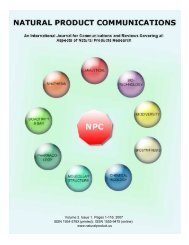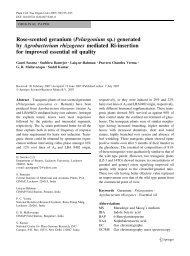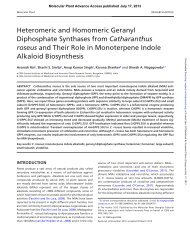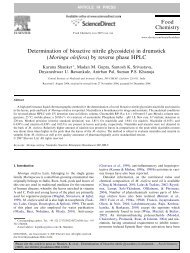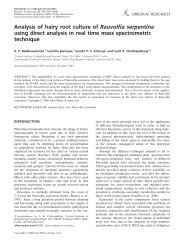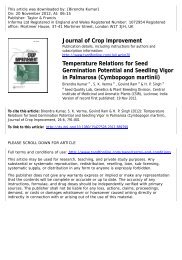Natural infection of periwinkle (Catharanthus roseus ... - CIMAP Staff
Natural infection of periwinkle (Catharanthus roseus ... - CIMAP Staff
Natural infection of periwinkle (Catharanthus roseus ... - CIMAP Staff
You also want an ePaper? Increase the reach of your titles
YUMPU automatically turns print PDFs into web optimized ePapers that Google loves.
34 Australasian Plant Disease Notes A. Samad et al.AMVRTase (10U) at 42 C for 90 min, in a total volume <strong>of</strong> 20 mLcontaining RNase inhibitor (25U), 1 mM each dNTP and adownstream primer (5 0 GCAT GGTACCTCAAACTGGGAGCAC-3 0 ). The PCR (25 mL) was performed using 2 mL <strong>of</strong> cDNA andprimers specific to CMV coat protein (CP, Srivastava et al. 2004)(F: 5 0 -GCATTCTAGA TGGACAAATCTGAATC-3 0 and R:5 0 GCATGGTACCTCA AACTGGGAGCAC-3 0 ) in anautomated thermal cycler (Perkin Elmer-Gene Amp PCRsystem 2400). The PCR cycles were, one initial cycle <strong>of</strong>denaturation at 94 C for 5 min followed by denaturation at94 C (1 min), annealing at 52 C (1 min) and extension at 72 Cfor 1.30 min. The final extension at 72 C was maintained for5 min. The PCR amplification product was separated byelectrophoresis in 1.2% agarose gel in 1X TAE and stainedwith ethidium bromide revealing an amplified DNA fragment<strong>of</strong> the expected size (~650 bp) from virus infected samplesonly but not from healthy samples (Fig. 4). DNA markerl/EcoRI+HindIII double digests were used as size markers.The amplified PCR product was cloned into pGEM-T Easyvector kit (Promega, USA), recombinant clones were identifiedby restriction digestion using the restriction endonucleaseenzyme EcoR1 and selected clones were sequenced using XL3130 Genetic Analyser (ABS, USA). The sequenced region wassubmitted to GenBank (Accession number EU310928) andcontained a single open reading frame, which comprised 657bases <strong>of</strong> nucleotides potentially coding for 218 amino acids. Thenew sequence was compared using bioinformatics tools DiAlign(Genomatrix) MEGA 4.0 with CP gene sequences <strong>of</strong> all availableCMV isolates from India as well as representative isolates fromother parts <strong>of</strong> the world belonging to both the subgroups (I and II)(Table 2). Nucleotide and deduced amino acid sequence <strong>of</strong> the CPgene <strong>of</strong> CMV infecting <strong>periwinkle</strong> showed closest identity (98%)with the subgroup IB CMV isolates from Rauvolfia serpentina(EF 593025) and with GenBank accession numbers. DQ640743and EF593026 (Fig. 5). On the basis <strong>of</strong> these biological andmolecular studies it is concluded that the virus naturally infecting<strong>periwinkle</strong> is a subgroup IB CMV. The high sequence identitiesobserved between Indian isolates <strong>of</strong> CMV compared with isolatesfrom other localities indicate that <strong>periwinkle</strong> isolate <strong>of</strong> CMVoriginated locally.AcknowledgementsThe authors are thankful to Dr S.P.S. Khanuja (Director, <strong>CIMAP</strong>) forencouragement and providing necessary facilities. Thanks also toDr AK Gupta, National Gene Bank <strong>of</strong> Medicinal and Aromatic Plants,<strong>CIMAP</strong>, Lucknow for providing the germplasm <strong>of</strong> <strong>periwinkle</strong> (C. <strong>roseus</strong>)for this study.ReferencesAglave BA, Krishnareddy M, Patil FS, Andhale MS (2007) MolecularIdentification <strong>of</strong> a Virus Causing Banana Chlorosis Disease fromMarathwada Region. International Journal <strong>of</strong> Biotechnology andBiochemistry 3, 13--23.Chatzivassiliou EK, Weekes R, Morris J, Wood KR, Barker I, Katis NI (2000)Tomato spotted wilt virus (TSWV) in Greece: its incidence following theexpansion <strong>of</strong> Frankliniella occidentalis, and characterisation <strong>of</strong> isolatescollected from various hosts. The Annals <strong>of</strong> Applied Biology 137,127--144. doi: 10.1111/j.1744-7348.2000.tb00044.xGibbs AJ, Harrison BD (1976) Physical and chemical methods <strong>of</strong> assay andanalysis. In ‘Plant virology -- The principles’. (Edward Arnold: London)Huang CH, Chang YC (2005) Identification and molecular characterization <strong>of</strong>Zantedeschia mild mosaic virus (ZaMMV), a new calla lily-infectingpotyvirus. Archives <strong>of</strong> Virology 150, 1221--1230. doi: 10.1007/s00705-004-0488-3Madhubala R, Bhadramurthy V, Bhat AI, Hareesh PS, Pretheesh ST,Bhai RS (2005) Occurrence <strong>of</strong> Cucumber mosaic virus on vanilla(Vanilla planifolia Andrews) in India. Journal <strong>of</strong> Biosciences 30,339--350. doi: 10.1007/BF02703671Noordam D (1973) ‘Identification <strong>of</strong> plant viruses: Methods andexperiments.’ (Centre for Agricultural Publishing and Documentation:Wageningen, The Netherlands)Palukaitis P, Roossinck MJ, Dietzgen RG, Francki RIB (1992) Cucumbermosaic virus. Advances in Virus Research 41, 281--348.Prince WC (1934) Isolation and study <strong>of</strong> some yellow strains <strong>of</strong> cucumbermosaic virus. Phytopathology 24, 743--761.Raj SK, Srivastava A, Chandra G, Singh BP (2002) Characterisation <strong>of</strong>Cucumber mosaic virus isolate infecting Gladiolus cultivars andcomparative analysis <strong>of</strong> serological and molecular methods forsensitive diagnosis. Current Science 83, 1132--1136.Raj SK, Kumar S, Pratap D, Vishnoi R, Snehi SK (2007) <strong>Natural</strong> Occurrence<strong>of</strong> Cucumber mosaic virus on Rauvolfia serpentina, a new record. PlantDisease 91, 322. doi: 10.1094/PDIS-91-3-0322CRaj SK, Kumar S, Snehi SK (2008) First Report <strong>of</strong> Cucumber mosaic viruson Jatropha curcas in India. Plant Disease 92, 171. doi: 10.1094/PDIS-92-1-0171CRoossinck MJ (1999) Cucumoviruses (Bromoviridae) -- general features.In ‘Encyclopedia <strong>of</strong> Virology’. 2nd edn (Eds L Grano<strong>of</strong>, RG Webster)pp. 315--320. (Academic Press: San Diego)Salazar LF, Muller G, Querci M, Zapata JL, Owens RA (2000) Potato yellowvein virus: its host range, distribution in South America and identificationas a crinivirus transmitted by Trialeurodes vaporariorum. The Annals <strong>of</strong>Applied Biology 137, 7--19. doi: 10.1111/j.1744-7348.2000.tb00052.xSamad A, Raj SK, Srivastava A, Chandra G, Ajayakumar PV, Zaim M,Singh BP (2000) Characterization <strong>of</strong> a cucumber mosaic virusisolates infecting Egyptian henbane (Hyoscyamus muticus L.) inIndia. Acta Virologica. English Ed. 44, 131--136.Sambrook J, Russell DW (2001) ‘Molecular cloning: A laboratory manual.’(Cold Spring Harbor Laboratory Press: New York)Singh HP, Hallan V, Raikhy G, Kulshrestha S, Sharma ML, Ram R, Garg ID,Zaidi AA (2005) Characterization <strong>of</strong> an Indian isolate <strong>of</strong> carnation mottlevirus infecting carnations. Current Science 88, 594--601.Srivastava A, Chandra G, Raj SK (2004) Molecular characterization <strong>of</strong> a strain<strong>of</strong> cucumber mosaic virus based on coat protein and movement proteingenes. Acta Virologica. English Ed. 48, 229--239.Stearn WT (1975) A synopsis <strong>of</strong> the genus <strong>Catharanthus</strong> (Apocynaceae).In ‘<strong>Catharanthus</strong> alkaloids’. (Eds WL Taylor, NR Fransworth) pp. 9--44.(Marcel Dekker: New York)Sudhakar N, Nagendra-Prasad D, Mohan N, Murugesan K (2006) First Report<strong>of</strong> Cucumber mosaic virus Subgroup II Infecting Lycopersiconesculentum in India. Plant Disease 90, 1457. doi: 10.1094/PD-90-1457BSvoboda GH, Blake DA (1975) The phytochemistry and pharmacology <strong>of</strong><strong>Catharanthus</strong> <strong>roseus</strong>. In ‘<strong>Catharanthus</strong> alkaloids’. (Eds WL Taylor,NR Fransworth) pp. 45--124. (Marcel Dekker: New York)Terami F, Fukumoto F, Handa K (2004) Cucumber mosaic virus isolated fromAmazon lily (Eucharis grandiflora). Journal <strong>of</strong> General Plant Pathology70, 192--193. doi: 10.1007/s10327-004-0104-0Verma N, Mahinghara BK, Ram R, Zaidi AA (2006) Coat proteinsequence shows that Cucumber mosaic virus isolate from geraniums(Pelargonium spp.) belongs to subgroup II. Journal <strong>of</strong> Biosciences31, 47--56. doi: 10.1007/BF02705234Zaim M, Khan MMAA (1988) Green mosaic <strong>of</strong> Hyoscyamus niger L. andRauvolfia serpentina Benth. Indian Journal <strong>of</strong> Plant Pathology 6,152--157.Manuscript received 30 January 2008, accepted 19 March 2008http://www.publish.csiro.au/journals/apdn




